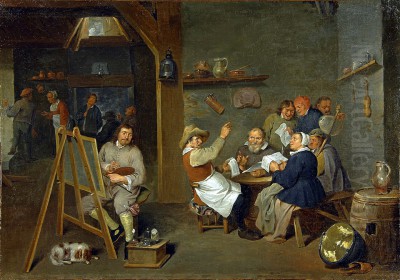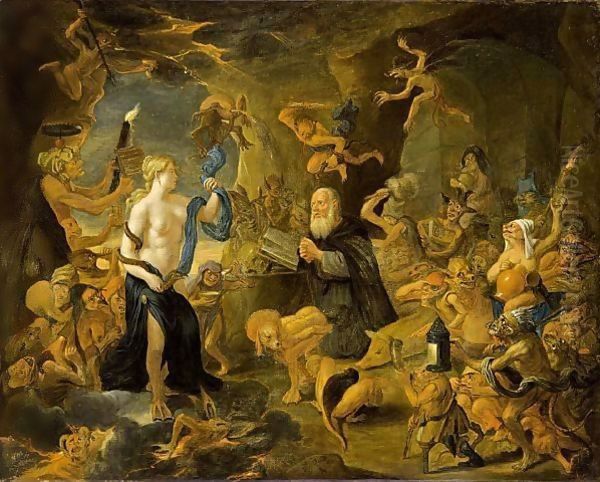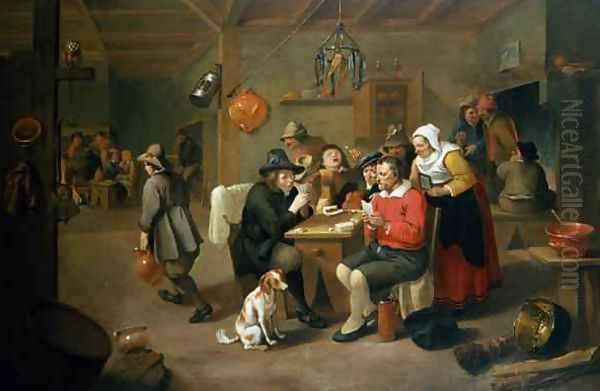
Matheus van Helmont (1623–c. 1679) was a prolific Flemish painter active primarily in Antwerp and later in Brussels during the vibrant Baroque period. He carved a distinct niche for himself by specializing in genre painting, capturing the essence of everyday life in the Southern Netherlands. His canvases frequently depict bustling peasant interiors, lively market scenes, and the intriguing, cluttered world of alchemists' laboratories. While influenced by prominent contemporaries, Van Helmont developed a recognizable style characterized by detailed observation and an engaging narrative quality. His name is consistently spelled Matheus van Helmont in art historical records, although variations like "Mattheus" or "Matthieu" occasionally appear, possibly stemming from regional phonetic differences or clerical errors over time.
Early Life and Artistic Formation in Antwerp
Born in Antwerp in 1623, Matheus van Helmont emerged during a golden age for Flemish art, albeit one increasingly overshadowed by the earlier titans like Peter Paul Rubens and Anthony van Dyck. It is crucial to distinguish Matheus, the painter, from his significantly more famous father, Jan Baptist van Helmont (1580–1644), a renowned chemist, physiologist, and physician, often considered the founder of pneumatic chemistry. While the son likely grew up in an environment where intellectual and scientific inquiry were valued, his path diverged towards the visual arts.
Details about his formal training remain somewhat scarce, a common issue for many artists of the period. However, the strong stylistic affinities in his work strongly suggest a connection to, or at least a deep admiration for, the output of David Teniers the Younger (1610–1690), the preeminent Flemish genre painter of the era. While direct pupilage under Teniers isn't definitively documented, Van Helmont absorbed much from Teniers's approach to composition, figure types, and subject matter. In 1645 or 1646, Matheus van Helmont achieved a significant professional milestone by being registered as a master painter in the prestigious Antwerp Guild of Saint Luke, signifying his official recognition as an independent artist qualified to take on pupils and sell his work.
Artistic Style and Dominant Influences

Matheus van Helmont's artistic style is firmly rooted in the Flemish genre tradition. His primary influence, David Teniers the Younger, is evident in his choice of subjects – particularly tavern scenes, peasant gatherings, and alchemists – and often in his compositional structures. Van Helmont adopted Teniers's method of populating scenes with numerous small, expressive figures engaged in various activities, creating a sense of lively, sometimes chaotic, energy.
Another significant influence was David Rijckart III (1612–1661), also known for his genre scenes, including workshops, peasant interiors, and fantastical subjects like the Temptation of St. Anthony. Rijckart's influence might be seen in Van Helmont's occasional depiction of artisan workshops and his detailed rendering of objects and textures within interior spaces. Furthermore, the raw, often boisterous peasant scenes painted by Adriaen Brouwer (1605/06–1638), though Brouwer died when Van Helmont was still a teenager, had a lasting impact on the entire Flemish genre school, and echoes of Brouwer's earthiness can sometimes be detected in Van Helmont's less idealized depictions of common life.
Despite these influences, Van Helmont developed his own stylistic traits. His figures, while clearly related to Teniers's types, often possess a slightly softer modeling. He excelled in rendering the interplay of light and shadow, particularly within interior settings, effectively creating atmosphere and focusing the viewer's attention. His works are generally characterized by careful execution, a rich, often warm palette, and a keen eye for anecdotal detail that brings his scenes to life. He was particularly adept at smaller-scale cabinet paintings, which were highly sought after by middle-class collectors.
Key Themes in Van Helmont's Oeuvre
Van Helmont explored several recurring themes throughout his career, each allowing him to showcase different facets of contemporary life and his artistic skill.
Peasant Life and Tavern Scenes
Like Teniers and Brouwer before him, Van Helmont frequently depicted scenes of peasant life. These range from relatively orderly domestic interiors, showing families at meals or engaged in simple chores, to more raucous tavern scenes and village festivities (kermesses). His taverns are often filled with figures drinking, smoking, playing cards, or interacting boisterously. These works capture the social customs and leisure activities of the lower classes, sometimes with a moralizing undertone, but often with a sense of lively observation. Compared to the Dutch painters of similar subjects, like Adriaen van Ostade (1610–1685) or Isaac van Ostade (1621–1649), Van Helmont's Flemish scenes often possess a slightly different palette and figure type, reflecting regional variations in style and perhaps social realities.
Bustling Market Scenes

Another favorite subject for Van Helmont was the outdoor market, particularly fruit and vegetable markets. His painting Fruit and Vegetable Market (96 x 116 cm), often cited as a representative work, exemplifies his approach to this theme. These scenes allowed him to depict a broader cross-section of society, from vendors hawking their wares to shoppers inspecting goods. He excelled at rendering the textures and colours of the produce and capturing the dynamic atmosphere of the marketplace. This theme had a long tradition in Flemish art, going back to painters like Pieter Aertsen (1508–1575) and Joachim Beuckelaer (c. 1533–c. 1575), who pioneered large-scale market and kitchen scenes. Van Helmont continued this tradition on a more intimate, cabinet-painting scale, similar in spirit to some Dutch market scenes by artists like Quiringh van Brekelenkam (c. 1622–c. 1669).
The Alchemist's Laboratory
Van Helmont is particularly noted for his depictions of alchemists in their laboratories. This theme was immensely popular in the 17th century, appealing to a fascination with science, pseudo-science, and the quest for knowledge or wealth (the philosopher's stone). His painting O Alquimista (The Alchemist) is a prime example. These works typically show the alchemist, often portrayed as a scholarly or obsessive figure, surrounded by the paraphernalia of his trade: furnaces, alembics, crucibles, mortars and pestles, glassware, books, and manuscripts. Assistants might be shown operating bellows or grinding materials.
Van Helmont’s alchemist scenes are rich in detail, meticulously rendering the cluttered interiors and the varied textures of metal, glass, pottery, and paper. They often capture the dramatic potential of the laboratory, with glowing fires illuminating the space. While his father was a legitimate chemist who distanced himself from fraudulent alchemy, Matheus the painter seemed fascinated by the visual and symbolic richness of the alchemist's world. His depictions align closely with those by David Teniers the Younger, who painted numerous variations on the theme. Other contemporaries exploring this subject included the Dutch painters Thomas Wijck (1616/17–1677), Cornelis Bega (c. 1631/32–1664), and Hendrick Heerschop (fl. 1643–1690), each bringing their own interpretation, ranging from scholarly pursuit to chaotic folly. Even Jan Steen (1626–1679) occasionally tackled the theme, often with a more satirical edge. Van Helmont's interpretations generally maintain a serious, observational tone.
Notable Works
Beyond the thematic categories, several specific works help illustrate Matheus van Helmont's skill and typical output:
The Alchemist (O Alquimista): This work, likely painted sometime between the 1640s and 1670s, is a quintessential example of his interest in the theme. It showcases his ability to organize a complex, cluttered space and render diverse objects with precision. The painting often invites interpretation regarding the relationship between emerging chemistry, traditional alchemy, and medicine, subjects certainly familiar within the Van Helmont household.
Fruit and Vegetable Market: As mentioned, this painting (96 x 116 cm, reportedly signed lower left) is a key example of his market scenes. It demonstrates his skill in handling larger compositions with multiple figures and detailed still-life elements, capturing the vibrancy of commercial life.
Interior Scene with Two Men near a Fireplace: This smaller painting (73 x 103 cm) highlights his ability to create intimate interior atmospheres. The focus on the hearth, the interplay of light and shadow, and the quiet interaction between the figures are characteristic of his skill in depicting domestic or tavern settings.
A Farmhand in a Pub: Representative of his many tavern scenes, this work likely focused on character study and the depiction of everyday leisure, using light effects to create mood and highlight textures.
The Temptation of St. Anthony: While one source mentions a "Tentations of Saint-Anne," it is far more probable that Van Helmont, like Teniers and Rijckart III, painted the extremely popular theme of the Temptation of St. Anthony. These scenes allowed artists to indulge in fantastical imagery, depicting grotesque demons and bizarre creatures tormenting the saint in his hermitage, offering a contrast to the realism of his other genre scenes.
Collaborations, Connections, and Recognition
Evidence suggests that Matheus van Helmont occasionally collaborated with other artists, a common practice in 17th-century Antwerp. He is known to have worked with the landscape painter Jacques d'Arthois (1613–1686). In such collaborations, d'Arthois would typically paint the expansive landscape settings, while Van Helmont would add the figures (staffage), integrating his genre elements into a broader view.
Art historically, Van Helmont's work has sometimes been compared or even confused with that of Gillis van Tilborgh (c. 1625–c. 1678), another Flemish genre painter active in Brussels around the same time. Both artists worked in a style influenced by Teniers, focusing on similar subjects like peasant gatherings and guardroom scenes, which can lead to attribution challenges for unsigned works.
While his name might not carry the same weight as Teniers or Brouwer, Van Helmont was a respected and highly productive painter in his time. His works were collected both locally and likely exported, fitting the demand for cabinet-sized genre paintings. His depictions of alchemists, in particular, remain significant contributions to this specific subgenre.
Later Career in Brussels and Legacy
Around 1670, Matheus van Helmont appears to have moved from Antwerp to Brussels, the administrative capital of the Spanish Netherlands. He continued to paint there, remaining active until close to his death. Records indicate he passed away around 1679, likely in Brussels.
Matheus van Helmont left behind a substantial body of work that provides valuable visual documentation of 17th-century Flemish life. He successfully navigated the artistic currents of his time, absorbing the influence of leading masters while maintaining a distinct and recognizable hand. His paintings are appreciated for their detailed execution, atmospheric interiors, lively figure groups, and engaging subject matter. While perhaps overshadowed by the biggest names of the Flemish Baroque, he remains an important figure in the rich tradition of Flemish genre painting, offering compelling glimpses into the taverns, markets, and laboratories of a bygone era. His works continue to be found in museums and private collections worldwide, testifying to his enduring appeal as a skilled chronicler of everyday life.